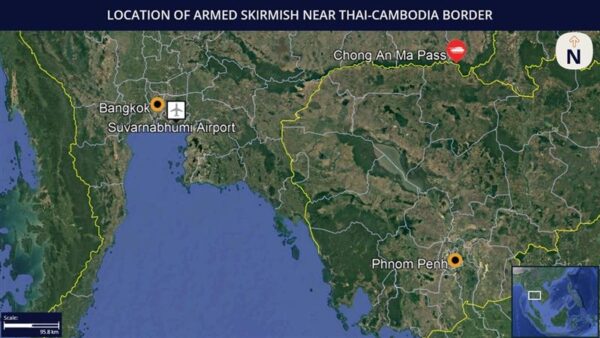27
Sep 2025
10:04 UTC
Cambodia & Thailand Alert: Armed clashes reported between Bangkok, Phnom Penh near Chong An Ma Pass in Ubon Ratchathani Province on September 27; significant escalations unlikely
Current Situation:
- Armed clashes were reported between Cambodian and Thai forces near the Chong An Ma Pass in Nam Yuen District, Ubon Ratchathani Province of Thailand, at approximately 11:52 (local time) on September 27.
- The Thai authorities stated that Cambodian soldiers opened fire using submachine guns and grenade launchers, targeting Thai army positions along the border area. Thai forces reportedly responded, and the exchange of gunfire lasted for approximately 30 minutes before subsiding.
- No injuries or fatalities have been reported as of writing.
- Cambodia’s Ministry of National Defence released an official statement asserting that Thai forces initiated the attack by launching mortar and small-arms fire, targeting a Cambodian military base in the An Seh area of Preah Vihar Province. The Cambodian military stated that it continues to monitor the situation and will act in full defense of its territorial sovereignty.
- The incident reportedly took place amid heightened tensions following a series of low-intensity border violations in recent weeks.
Source: Bangkok Post, Khmer Times
Assessments & Forecast:
- The recent border skirmish at Chong An Ma underscores the persistent fragility of the ceasefire agreement signed between Cambodia and Thailand on July 28, particularly along historically disputed areas of the eastern frontier. While the confrontation de-escalated within an hour, the possibility of renewed localized clashes in the near term remains high, given the persistent volatility along the disputed border and the reciprocal inflammatory rhetoric of both Bangkok and Phnom Penh, each attributing responsibility for the incident to the other. Moreover, military posturing in the Ubon Ratchathani border region is likely to escalate, marked by intensified aerial surveillance and reinforced troop deployments by both sides. Cross-border movement is expected to remain suspended given the recent flare-ups in the border areas and previously implemented closures.
- Despite the clash, the likelihood of the escalation into a full-scale armed conflict remains low, consistent with previous incidents along the Thai-Cambodian border where both governments have sought to contain hostilities. Both sides appear to prefer limited, localized engagements rather than sustained confrontation, reflecting a pattern of restraint. Domestic political considerations are also expected to act as constraints. This includes the new administration under Prime Minister Anutin Charnvirakul, which focuses on coalition stability and economic priorities, while Cambodia faces pressure from potential domestic backlash if the government is seen as provoking instability. Additionally, the likelihood of broader conflict is further attenuated by intensifying diplomatic pressure, particularly from Malaysia, which has urged both Bangkok and Phnom Penh to endorse the ASEAN Observer Team (AOT) framework during the forthcoming 47th ASEAN Summit in October.
- The timing of the clash is also significant, occurring just a day after Thai Prime Minister Anutin announced plans for a national referendum on revoking longstanding border agreements with Cambodia. Against this backdrop, both governments are likely to intensify allegations to portray the other as the aggressor in order to shape international opinion. Nevertheless, the risk of recurring skirmishes in the short term remains elevated, driven by poorly demarcated border zones with dense troop presence and the potential for localized disputes between field units. Political leaders on both sides could tolerate limited clashes as a means of projecting strength without escalating into a broader conflict. In the near term, these developments suggest that sporadic but contained incidents will persist even as diplomatic channels are activated to manage tensions. Heightened security is expected to continue, with businesses reliant on cross-border trade facing disruptions.
Recommendations:
- We advise against nonessential travel to the areas near the Thai-Cambodia border on September 27 and over the coming days due to the ongoing bilateral tensions and associated high security measures.
- Travel to Bangkok and Phnom Penh may continue while adhering to standard security precautions due to high protest sentiment.
- It is advised to avoid politically related protests due to the risk of police intervention and unrest.
COUNTRY RISK LEVEL
Medium
AFFECTED AREA
Cambodia & Thailand
INCIDENT RISK LEVEL
High
STRENGTH OF SOURCE
Credible
Current Situation:
- Armed clashes were reported between Cambodian and Thai forces near the Chong An Ma Pass in Nam Yuen District, Ubon Ratchathani Province of Thailand, at approximately 11:52 (local time) on September 27.
- The Thai authorities stated that Cambodian soldiers opened fire using submachine guns and grenade launchers, targeting Thai army positions along the border area. Thai forces reportedly responded, and the exchange of gunfire lasted for approximately 30 minutes before subsiding.
- No injuries or fatalities have been reported as of writing.
- Cambodia’s Ministry of National Defence released an official statement asserting that Thai forces initiated the attack by launching mortar and small-arms fire, targeting a Cambodian military base in the An Seh area of Preah Vihar Province. The Cambodian military stated that it continues to monitor the situation and will act in full defense of its territorial sovereignty.
- The incident reportedly took place amid heightened tensions following a series of low-intensity border violations in recent weeks.
Source: Bangkok Post, Khmer Times
Assessments & Forecast:
- The recent border skirmish at Chong An Ma underscores the persistent fragility of the ceasefire agreement signed between Cambodia and Thailand on July 28, particularly along historically disputed areas of the eastern frontier. While the confrontation de-escalated within an hour, the possibility of renewed localized clashes in the near term remains high, given the persistent volatility along the disputed border and the reciprocal inflammatory rhetoric of both Bangkok and Phnom Penh, each attributing responsibility for the incident to the other. Moreover, military posturing in the Ubon Ratchathani border region is likely to escalate, marked by intensified aerial surveillance and reinforced troop deployments by both sides. Cross-border movement is expected to remain suspended given the recent flare-ups in the border areas and previously implemented closures.
- Despite the clash, the likelihood of the escalation into a full-scale armed conflict remains low, consistent with previous incidents along the Thai-Cambodian border where both governments have sought to contain hostilities. Both sides appear to prefer limited, localized engagements rather than sustained confrontation, reflecting a pattern of restraint. Domestic political considerations are also expected to act as constraints. This includes the new administration under Prime Minister Anutin Charnvirakul, which focuses on coalition stability and economic priorities, while Cambodia faces pressure from potential domestic backlash if the government is seen as provoking instability. Additionally, the likelihood of broader conflict is further attenuated by intensifying diplomatic pressure, particularly from Malaysia, which has urged both Bangkok and Phnom Penh to endorse the ASEAN Observer Team (AOT) framework during the forthcoming 47th ASEAN Summit in October.
- The timing of the clash is also significant, occurring just a day after Thai Prime Minister Anutin announced plans for a national referendum on revoking longstanding border agreements with Cambodia. Against this backdrop, both governments are likely to intensify allegations to portray the other as the aggressor in order to shape international opinion. Nevertheless, the risk of recurring skirmishes in the short term remains elevated, driven by poorly demarcated border zones with dense troop presence and the potential for localized disputes between field units. Political leaders on both sides could tolerate limited clashes as a means of projecting strength without escalating into a broader conflict. In the near term, these developments suggest that sporadic but contained incidents will persist even as diplomatic channels are activated to manage tensions. Heightened security is expected to continue, with businesses reliant on cross-border trade facing disruptions.
Recommendations:
- We advise against nonessential travel to the areas near the Thai-Cambodia border on September 27 and over the coming days due to the ongoing bilateral tensions and associated high security measures.
- Travel to Bangkok and Phnom Penh may continue while adhering to standard security precautions due to high protest sentiment.
- It is advised to avoid politically related protests due to the risk of police intervention and unrest.


